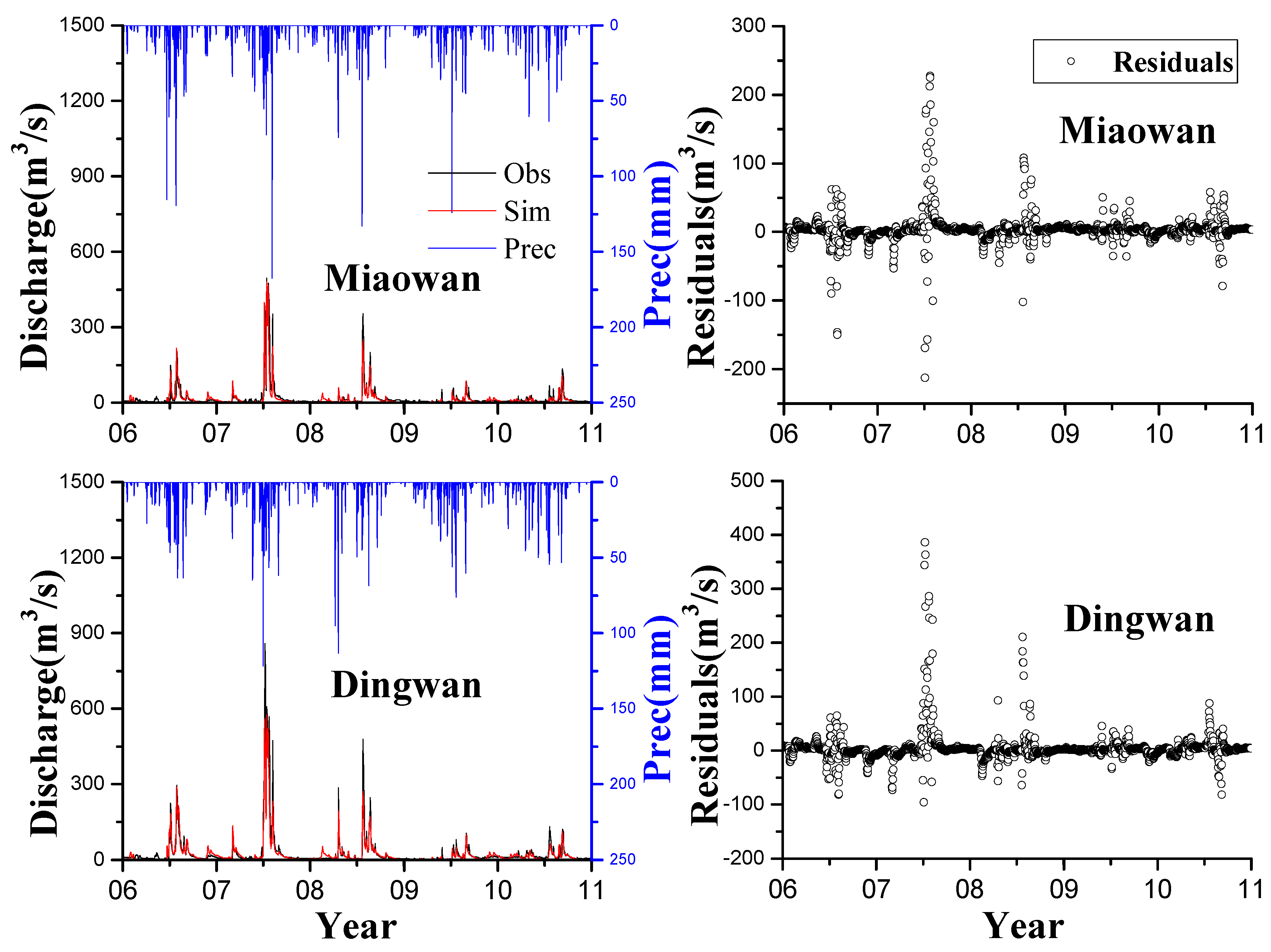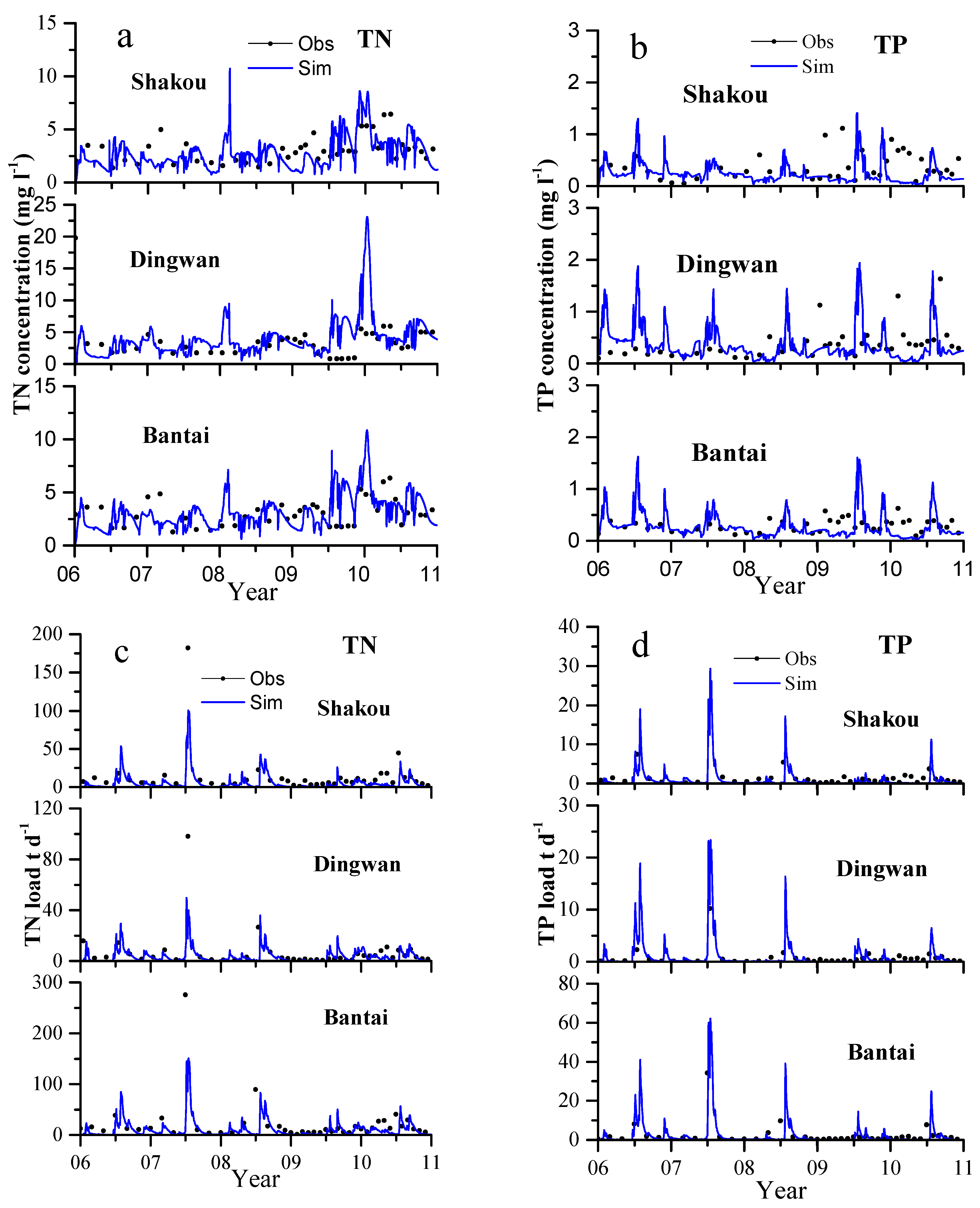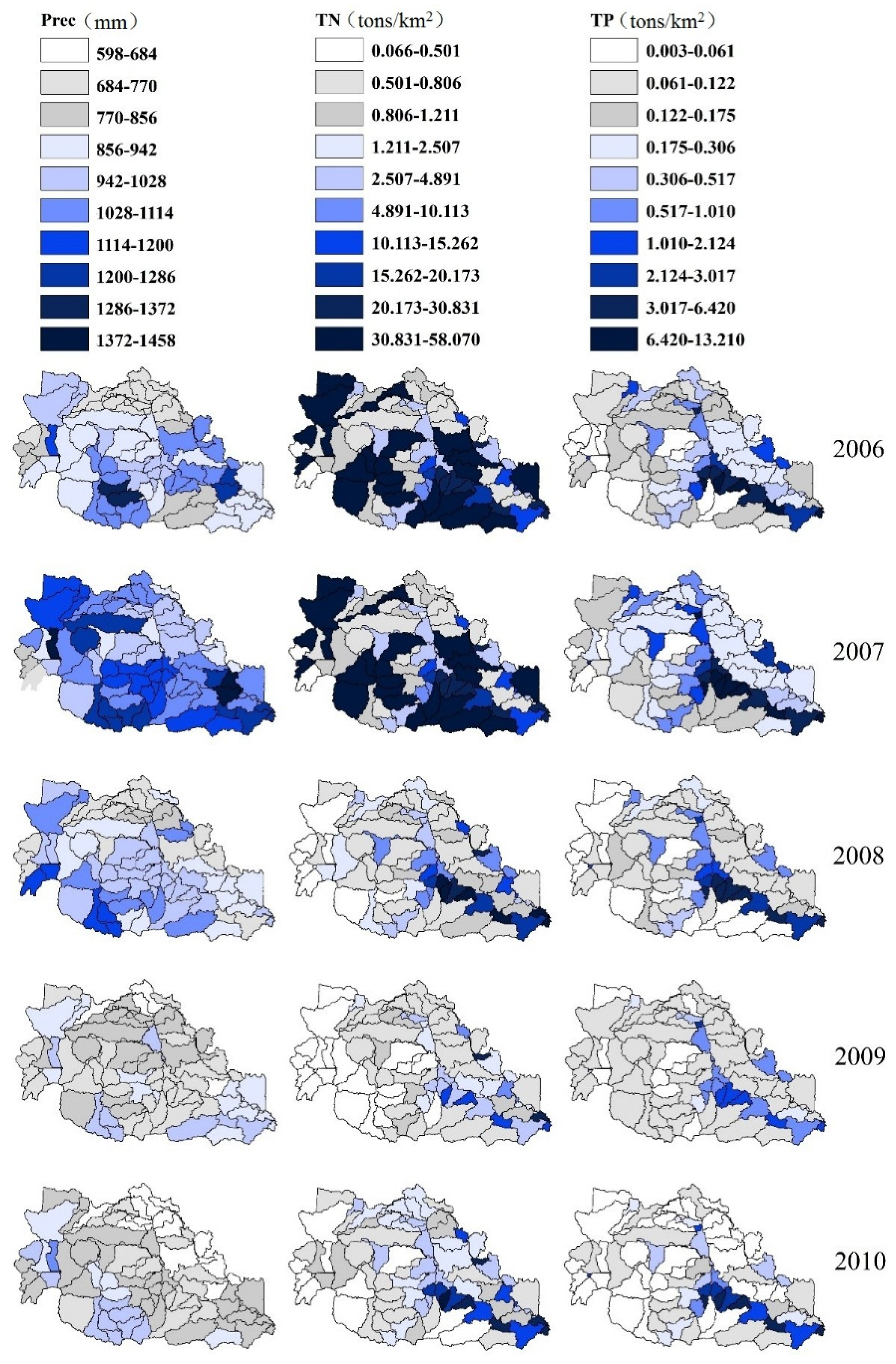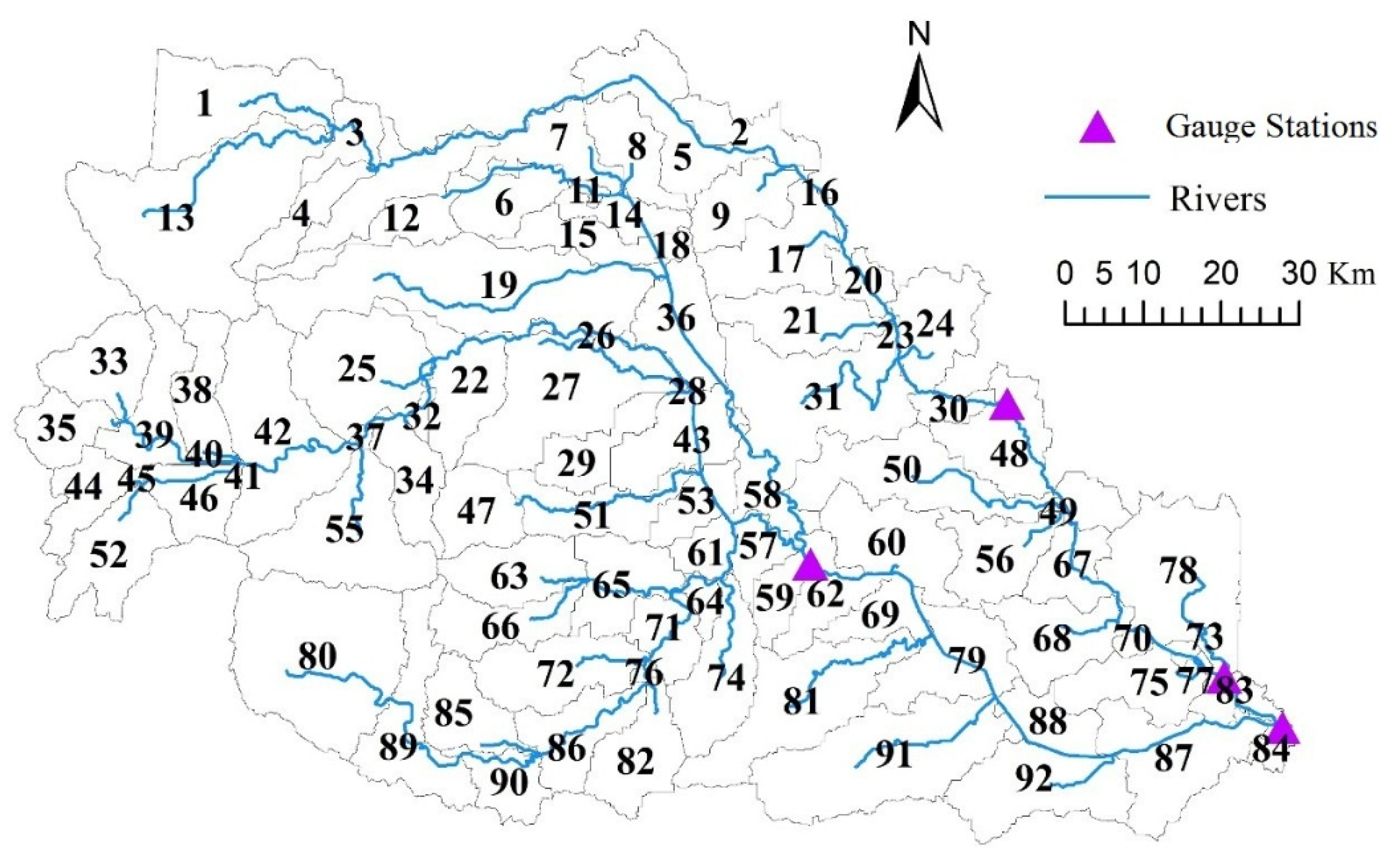Assessment of the Spatial and Temporal Variations of Water Quality for Agricultural Lands with Crop Rotation in China by Using a HYPE Model
Abstract
:1. Introduction
2. Materials and Methods
2.1. HYPE Model
2.2. Study Area and Data
2.3. Model Setup and Parameter Calibration
3. Results and Discussion
3.1. Model Parameter Calibration and Validation
3.2. Hydrological Simulation
3.3. TN and TP Simulations
3.3.1. TN and TP Concentrations and Daily Load Simulations
3.3.2. Monthly Yields of TN and TP Load Simulations
3.3.3. Annual Yields of TN and TP Load Simulations in Each Sub-Basin
3.4. Future Work
4. Conclusions
Acknowledgments
Author Contributions
Conflicts of Interest
References
- Hecky, R.E.; Kilham, P. Nutrient limitation of phytoplankton in freshwater and marine environments: A review of recent evidence on the effects of enrichment1. Oceanography 1988, 33, 796–822. [Google Scholar] [CrossRef]
- Howarth, R.W. Nutrient limitation of net primary production in marine ecosystems. Ann. Rev. Ecol. Syst. 1988, 19, 89–110. [Google Scholar] [CrossRef]
- Maier, G.; Glegg, G.A.; Tappin, A.D.; Worsfold, P.J. The use of monitoring data for identifying factors influencing phytoplankton bloom dynamics in the eutrophic Taw Estuary, SW England. Mar. Pollut. Bull. 2009, 58, 1007–1015. [Google Scholar] [CrossRef] [PubMed]
- Smith, V.H. Eutrophication of freshwater and coastal marine ecosystems a global problem. Environ. Sci. Pollut. Res. 2003, 10, 126–139. [Google Scholar] [CrossRef]
- Liu, W.; Zhang, Q.; Liu, G. Lake eutrophication associated with geographic location, lake morphology and climate in China. Hydrobiologia 2010, 644, 289–299. [Google Scholar] [CrossRef]
- Viney, N.R.; Sivapalan, M.; Deeley, D. A conceptual model of nutrient mobilisation and transport applicable at large catchment scales. J. Hydrol. 2000, 240, 23–44. [Google Scholar] [CrossRef]
- Somura, H.; Takeda, I.; Arnold, J.G.; Mori, Y.; Jeong, J.; Kannan, N.; Hoffman, D. Impact of suspended sediment and nutrient loading from land uses against water quality in the Hii River Basin, Japan. J. Hydrol. 2012, 450, 25–35. [Google Scholar] [CrossRef]
- Wang, Y.; Li, Y.; Liu, X.; Liu, F.; Li, Y.; Song, L.; Li, H.; Ma, Q.; Wu, J. Relating land use patterns to stream nutrient levels in red soil agricultural catchments in subtropical central China. Environ. Sci. Pollut. Res. 2014, 21, 10481–10492. [Google Scholar] [CrossRef] [PubMed]
- Zhai, X.; Xia, J.; Zhang, Y. Water quality variation in the highly disturbed Huai River Basin, China from 1994 to 2005 by multi-statistical analyses. Sci. Total Environ. 2014, 496, 594–606. [Google Scholar] [CrossRef] [PubMed]
- Jiang, S.; Jomaa, S.; Rode, M. Modelling inorganic nitrogen leaching in nested mesoscale catchments in central Germany. Ecohydrology 2014, 7, 1345–1362. [Google Scholar] [CrossRef]
- Liu, F.; Parmenter, R.; Brooks, P.D.; Conklin, M.H.; Bales, R.C. Seasonal and interannual variation of streamflow pathways and biogeochemical implications in semi-arid, forested catchments in Valles Caldera, New Mexico. Ecohydrology 2008, 1, 239–252. [Google Scholar] [CrossRef]
- Lam, Q.D.; Schmalz, B.; Fohrer, N. Assessing the spatial and temporal variations of water quality in lowland areas, Northern Germany. J. Hydrol. 2012, 438–439, 137–147. [Google Scholar] [CrossRef]
- Michael, R.; Enrico, T.; Uwe, F.; Gerald, W.; Fred, H. Impact of selected agricultural management options on the reduction of nitrogen loads in three representative meso scale catchments in Central Germany. Sci. Total Environ. 2009, 407, 3459–3472. [Google Scholar]
- Basu, N.B.; Georgia, D.; Jawitz, J.W.; Thompson, S.E.; Loukinova, N.V.; Amélie, D.; Stefano, Z.; Mary, Y.; Murugesu, S.; Andrea, R. Nutrient loads exported from managed catchments reveal emergent biogeochemical stationarity. Geophys. Res. Lett. 2010, 37, 817–824. [Google Scholar] [CrossRef]
- Shrestha, R.R.; Dibike, Y.B.; Prowse, T.D. Modeling climate change impacts on hydrology and nutrient loading in the upper Assiniboine Catchment1. J. Am. Water Resour. Assoc. 2012, 48, 74–89. [Google Scholar] [CrossRef]
- Zhang, T. Distance-decay patterns of nutrient loading at watershed scale: Regression modeling with a special spatial aggregation strategy. J. Hydrol. 2011, 402, 239–249. [Google Scholar] [CrossRef]
- Hansen, B.; Alrøe, H.F.; Kristensen, E.S. Approaches to assess the environmental impact of organic farming with particular regard to Denmark. Agric. Ecosyst. Environ. 2001, 83, 11–26. [Google Scholar] [CrossRef]
- Andersen, H.E.; Kronvang, B.; Larsen, S.E.; Hoffmann, C.C.; Jensen, T.S.; Rasmussen, E.K. Climate-change impacts on hydrology and nutrients in a Danish lowland river basin. Sci. Total Environ. 2006, 365, 223–237. [Google Scholar] [CrossRef] [PubMed]
- Bouraoui, F.; Grizzetti, B.; Granlund, K.; Rekolainen, S.; Bidoglio, G. Impact of climate change on the water cycle and nutrient losses in a Finnish catchment. Clim. Chang. 2004, 66, 109–126. [Google Scholar] [CrossRef]
- De Klein, J.J.M.; Koelmans, A.A. Quantifying seasonal export and retention of nutrients in West European lowland rivers at catchment scale. Hydrol. Processes 2011, 25, 2102–2111. [Google Scholar] [CrossRef]
- Li, H.; Sivapalan, M.; Tian, F.; Liu, D. Water and nutrient balances in a large tile-drained agricultural catchment: A distributed modeling study. Hydrol. Earth Syst. Sci. 2010, 14, 2259–2275. [Google Scholar] [CrossRef]
- Yao, H.; Creed, I.F. Determining Spatially-Distributed Annual Water Balances for Ungauged Locations on Shikoku Island, Japan: A Comparison of Two Interpolators/Détermination de Bilans Hydriques Spatialisés pour des Sites Non-Jaugés de L’Īle de Shikoku, au Japon: Comparaison de Deux Interpolateurs. Hydrol. Sci. J. Des. Sci. Hydrol. 2005, 50. [Google Scholar] [CrossRef]
- Ullrich, A.; Volk, M. Influence of different nitrate-N monitoring strategies on load estimation as a base for model calibration and evaluation. Environ. Monit. Assess. 2010, 171, 513–527. [Google Scholar] [CrossRef] [PubMed]
- Min, Y.; Rene, K. Simulating the evolution of non-point source pollutants in a shallow water environment. Chemosphere 2007, 67, 879–885. [Google Scholar]
- Arnold, J.G.; Allen, P.M. Estimating hydrologic budgets for three Illinois watersheds. J. Hydrol. 1996, 176, 57–77. [Google Scholar] [CrossRef]
- Williams, J.R.; Nicks, A.D.; Arnold, J.G. Simulator for water resources in Rural Basins. Am. Soc. Civil Eng. 2014, 111, 970–986. [Google Scholar] [CrossRef]
- Beasley, D.B.; Huggins, L.F.; Monke, E.J. ANSWERS: A model for watershed planning. Trans. Am. Soc. Agric. Eng. 1980, 23, 938–944. [Google Scholar] [CrossRef]
- Chahinian, N.; Tournoud, M.-G.; Perrin, J.-L.; Picot, B. Flow and nutrient transport in intermittent rivers: A modelling case-study on the Vène River using SWAT 2005. Hydrol. Sci. J. Des. Sci. Hydrol. 2011, 56, 268–287. [Google Scholar] [CrossRef]
- Glavan, M.; White, S.; Holman, I.P. Evaluation of river water quality simulations at a daily time step—Experience with SWAT in the Axe Catchment, UK. Clean Soil Air Water 2011, 39, 43–54. [Google Scholar] [CrossRef]
- Andersson, L.; Rosberg, J.; Pers, B.; Olsson, J.; Arheimer, B. Estimating catchment nutrient flow with the HBV-NP model: Sensitivity to input data. AMBIO 2005, 34, 521–532. [Google Scholar] [CrossRef] [PubMed]
- Arheimer, B.; Lwgren, M.; Pers, B.C.; Rosberg, J. Integrated catchment modeling for nutrient reduction: Scenarios showing impacts, potential, and cost of measures. AMBIO 2005, 34, 513–520. [Google Scholar] [CrossRef] [PubMed]
- Lindström, G.; Pers, C.; Rosberg, J.; Strömqvist, J.; Arheimer, B. Development and testing of the HYPE (Hydrological Predictions for the Environment) water quality model for different spatial scales. Hydrol. Res. 2010, 41, 295–319. [Google Scholar] [CrossRef]
- Lindstrm, G.; Rosberg, J.; Arheimer, B. Parameter precision in the HBV-NP model and impacts on nitrogen scenario simulations in the Rönneå River, Southern Sweden. AMBIO 2005, 34, 533–537. [Google Scholar] [CrossRef]
- Strömqvist, J.; Arheimer, B.; Dahné, J.; Donnelly, C.; Lindström, G. Water and nutrient predictions in ungauged basins: Set-up and evaluation of a model at the national scale. Hydrol. Sci. J. 2012, 57, 229–247. [Google Scholar] [CrossRef]
- Wriedt, G.; Rode, M. Modelling nitrate transport and turnover in a lowland catchment system. J. Hydrol. 2006, 328, 157–176. [Google Scholar] [CrossRef]
- Arheimer, B.; Dahné, J.; Donnelly, C.; Lindström, G.; Strömqvist, J. Water and nutrient simulations using the HYPE model for Sweden vs. the Baltic Sea basin—Influence of input-data quality and scale. Hydrol. Res. 2012, 43, 315–329. [Google Scholar] [CrossRef]
- Li, Z.-G.; Zhang, G.-S.; Liu, Y.; Wan, K.-Y.; Zhang, R.-H.; Chen, F. Soil nutrient assessment for urban ecosystems in Hubei, China. PLoS ONE 2013, 8, e75856. [Google Scholar] [CrossRef] [PubMed]
- Youjun, L.; Ming, H. Effects of tillage managements on soil rapidly available nutrient content and the yield of winter wheat in West Henan province, China. Proced. Environ. Sci. 2011, 11, 843–849. [Google Scholar]
- Lan, C.; Giambelluca, T.W.; Ziegler, A.D. Lumped parameter sensitivity analysis of a distributed hydrological model within tropical and temperate catchments. Hydrol. Processes 2011, 25, 2405–2421. [Google Scholar]
- Doherty, J. PEST: Model-Independent Parameter Estimation, User Mannual, 5th ed.; Watermark Numerical Computing: Brisbane, Australia, 2005. [Google Scholar]
- Lu, S.; Kayastha, N.; Thodsen, H.; Van, G.A.; Andersen, H.E. Multiobjective calibration for comparing channel sediment routing models in the soil and water assessment tool. J. Environ. Qual. 2014, 43, 110–120. [Google Scholar] [CrossRef] [PubMed]
- Rode, M.; Suhr, U.; Wriedt, G. Multi-objective calibration of a river water quality model—Information content of calibration data. Ecol. Model. 2007, 204, 129–142. [Google Scholar] [CrossRef]
- Griensven, A.V.; Bauwens, W. Multiobjective autocalibration for semidistributed water quality models. Water Resour. Res. 2003, 39. [Google Scholar] [CrossRef]
- Bahremand, A.; Smedt, F.D. Predictive analysis and simulation uncertainty of a distributed hydrological model. Water Resour. Manag. 2010, 24, 2869–2880. [Google Scholar] [CrossRef]
- Gupta, H.V.; Sorooshian, S.; Yapo, P.O.; Gupta, H.V.; Yapo, P.O. Status of automatic calibration for hydrologic models: Comparison with multilevel expert calibration. J. Hydrol. Eng. 2014, 4, 135–143. [Google Scholar] [CrossRef]
- Moriasi, D.N.; Arnold, J.G.; Liew, M.W.V.; Bingner, R.L.; Harmel, R.D.; Veith, T.L. Model evaluation guidelines for systematic quantification of accuracy in watershed simulations. Trans. Asabe 2007, 50, 885–900. [Google Scholar] [CrossRef]
- Nash, J.E.; Sutcliffe, J.V. River flow forecasting through conceptual models part I—A discussion of principles. J. Hydrol. 1970, 10, 282–290. [Google Scholar] [CrossRef]
- Wang, Q.J.; Pagano, T.C.; Zhou, S.L.; Hapuarachchi, H.A.P.; Zhang, L.; Robertson, D.E. Monthly versus daily water balance models in simulating monthly runoff. J. Hydrol. 2011, 404, 166–175. [Google Scholar] [CrossRef]
- Bennett, J.C.; Robertson, D.E.; Ward, P.G.D.; Hapuarachchi, H.A.P.; Wang, Q.J. Calibrating hourly rainfall-runoff models with daily forcings for streamflow forecasting applications in meso-scale catchments. Environ. Model. Softw. 2016, 76, 20–36. [Google Scholar] [CrossRef]
- Ouyang, W.; Huang, H.; Hao, F.; Guo, B. Synergistic impacts of land-use change and soil property variation on non-point source nitrogen pollution in a freeze-thaw area. J. Hydrol. 2013, 495, 126–134. [Google Scholar] [CrossRef]
- Baker, T.J.; Miller, S.N. Using the Soil and Water Assessment Tool (SWAT) to assess land use impact on water resources in an East African watershed. J. Hydrol. 2013, 486, 100–111. [Google Scholar] [CrossRef]
- Ibrahim, H.M.; Huggins, D.R. Spatio-temporal patterns of soil water storage under dryland agriculture at the watershed scale. J. Hydrol. 2011, 404, 186–197. [Google Scholar] [CrossRef]
- Finger, D.; Vis, M.; Huss, M.; Seibert, J. The value of multiple data set calibration versus model complexity for improving the performance of hydrological models in mountain catchments. Water Resour. Res. 2015, 51, 1939–1958. [Google Scholar] [CrossRef]
- Bell, L.W.; Sparling, B.; Tenuta, M.; Entz, M.H. Soil profile carbon and nutrient stocks under long-term conventional and organic crop and alfalfa-crop rotations and re-established grassland. Agric. Ecosyst. Environ. 2012, 158, 156–163. [Google Scholar] [CrossRef]
- Houx Iii, J.H.; Wiebold, W.J.; Fritschi, F.B. Long-term tillage and crop rotation determines the mineral nutrient distributions of some elements in a Vertic Epiaqualf. Soil Tillage Res. 2011, 112, 27–35. [Google Scholar] [CrossRef]
- Parajuli, P.B.; Jayakody, P.; Sassenrath, G.F.; Ouyang, Y.; Pote, J.W. Assessing the impacts of crop-rotation and tillage on crop yields and sediment yield using a modeling approach. Agric. Water Manag. 2013, 119, 32–42. [Google Scholar] [CrossRef]
- Frisbee, M.D.; Wilson, J.L.; Gomez-Velez, J.D.; Phillips, F.M.; Campbell, A.R. Are we missing the tail (and the tale) of residence time distributions in watersheds? Geophys. Res. Lett. 2013, 40, 4633–4637. [Google Scholar] [CrossRef]
- Hofstra, N.; Bouwman, A.F. Denitrification in agricultural soils: Summarizing published data and estimating global annual rates. Nutr. Cycl. Agroecosyst. 2005, 72, 267–278. [Google Scholar] [CrossRef]
- Sweeney, D.W.; Pierzynski, G.M.; Barnes, P.L. Nutrient losses in field-scale surface runoff from claypan soil receiving Turkey litter and fertilizer. Agric. Ecosyst. Environ. 2012, 150, 19–26. [Google Scholar] [CrossRef]
- Lang, M.; Cai, Z.-C.; Mary, B.; Hao, X.; Chang, S.X. Land-use type and temperature affect gross nitrogen transformation rates in Chinese and Canadian soils. Plant Soil 2010, 334, 377–389. [Google Scholar] [CrossRef]
- Kiedrzyńska, E.; Kiedrzyński, M.; Urbaniak, M.; Magnuszewski, A.; Skłodowski, M.; Wyrwicka, A.; Zalewski, M. Point sources of nutrient pollution in the lowland river catchment in the context of the Baltic Sea eutrophication. Ecol. Eng. 2014, 70, 337–348. [Google Scholar] [CrossRef]
- Chen, D.; Dahlgren, R.A.; Lu, J. A modified load apportionment model for identifying point and diffuse source nutrient inputs to rivers from stream monitoring data. J. Hydrol. 2013, 501, 25–34. [Google Scholar] [CrossRef]
- Ouyang, W.; Skidmore, A.K.; Toxopeus, A.G.; Hao, F. Long-term vegetation landscape pattern with non-point source nutrient pollution in upper stream of Yellow River Basin. J. Hydrol. 2010, 389, 373–380. [Google Scholar] [CrossRef]
- Nan, W.; Yue, S.; Li, S.; Huang, H.; Shen, Y. Characteristics of N2O production and transport within soil profiles subjected to different nitrogen application rates in China. Sci. Total Environ. 2016, 542, 864–875. [Google Scholar] [CrossRef] [PubMed]
- Bai, J.; Ye, X.; Zhi, Y.; Gao, H.; Huang, L.; Xiao, R.; Shao, H. Nitrate-nitrogen transport in horizontal soil columns of the Yellow River Delta wetland, China. Clean Soi Air Water 2012, 40, 1106–1110. [Google Scholar] [CrossRef]
- Son, J.-H.; Watson, C.C.; Biedenharn, D.S.; Carlson, K.H. Reactive stream stabilization for minimizing transport of phosphorus and nitrogen from agricultural landscapes (Report). J. Water Resour. Prot. 2011, 3, 504. [Google Scholar] [CrossRef]
- Arheimer, B.; Lidén, R. Nitrogen and phosphorus concentrations from agricultural catchments—Influence of spatial and temporal variables. J. Hydrol. 2000, 227, 140–159. [Google Scholar] [CrossRef]







| Crop Rotation | Crops | Date | Simplified Operation | Elemental Fertilizer (kg·ha−1) |
|---|---|---|---|---|
| Rotation 1 | Winter wheat | 7 October | Fertilization N:P | 300:120 |
| 8 October | Soil tillage | |||
| 8 October | Planting | |||
| 5 March | Fertilization N | 43 | ||
| 15 May | Harvest | |||
| Maize | 15 June | Soil tillage | ||
| 17 June | Fertilization N:P | 300:120 | ||
| 17 June | Planting | |||
| 2 August | Fertilization N | 84 | ||
| 18 September | Harvest | |||
| Rotation 2 | Winter wheat | 7 October | Fertilization N:P | 300:120 |
| 8 October | Soil tillage | |||
| 8 October | Planting | |||
| 5 March | Fertilization N | 43 | ||
| 15 May | Harvest | |||
| Peanuts | 2 June | Soil tillage | ||
| 4 June | Planting | |||
| 4 June | Fertilization N:P | 90:90 | ||
| 15 September | Harvest |
| Category | Miaowan | Dingwan | Shakou | Bantai |
|---|---|---|---|---|
| Mean TN concentrations (mg/L) | - | 3.79 | 2.89 | 2.96 |
| Mean TP concentrations (mg/L) | - | 0.23 | 0.34 | 0.28 |
| Mean discharge (m3/s) | 15.87 | 23.24 | 42.48 | 74.34 |
| Data Type | Data Description/Properties | Resolution | Source |
|---|---|---|---|
| Geographical data | Elevation | 30 m | Chinese National Geomatics Center |
| Stream network | - | ||
| Land use | 25 m | ||
| Soil type | 25 m | ||
| Meteorological data | Daily precipitation | 45 stations | Chinese Meteorological Administration |
| Air temperature | 1 station (Zhumadian) | Chinese Ministry of Water Resources | |
| Agricultural practices | Manure and fertilizer, timing and amount for fertilization, sowing, and harvesting | - | Field survey (117 farmers) |
| Soil nitrogen content | Initial nitrogen storage | - | Literature review [37,38] |
| Sewage treatment plants | Water flow and TN and TP concentrations | - | Operating reports of sewage treatment plants |
| Parameter | Physical Meaning | Initial Value | Initial Range | Relative Composite Sensitivity | Optimized Value | 95% Confidence Limits |
|---|---|---|---|---|---|---|
| cevp | ||||||
| Forest | Potential evapotranspiration rate ( mm·day−1·°C−1) | 0.16 | 0.01–1 | 0.0014 | 0.17 | 0.141–0.195 |
| Plain dry land | 0.097 | 0.001–1 | 0.0075 | 0.0975 | 0.0967–0.0976 | |
| rrcs1 | ||||||
| Luvisols | Soil runoff coefficient for the uppermost soil layer (day−1) | 0.4 | 0.01–1 | 0.0004 | 0.3 | 0.337–0.512 |
| Leptosols-lithic | 0.18 | 0.01–1 | 0.0005 | 0.15 | 0.135–0.19 | |
| wcep | ||||||
| Luvisols | Effective porosity as a fraction | 0.11 | 0.01–1 | 0.0009 | 0.113 | 0.108-0.124 |
| Cambisols | 0.0005 | 1 × 10−5–1 | 0.0087 | 0.000544 | 4.93 × 10−4–5.56 × 10−4 | |
| Gleysols | 0.0002 | 1 × 10−5–1 | 0.010 | 0.00045 | 0.0001–5.2 × 10−4 | |
| rivvel | celerity of flood in watercourse (m·s−1) | 1.202 | 0.1–10 | 0.0083 | 1.149 | 1.135–1.157 |
| cevpcorr | Correction factor for evapotranspiration | 0.1 | 0.01–1 | 0.0009 | 0.12 | 0.08–0.157 |
| rivvel2 | parameter for calculation of velocity of the water in the watercourse | 0.94 | 0.01–1 | 0.0005 | 0.104 | 0.713–1.294 |
| sedon | sedimentation rate of ON in lakes (m·d−1) | 0.002 | 0.0001–1 | 0.0002 | 0.001 | 0.0029–0.0004 |
| wprodn | production/decay of N in water (kg·m−3·d−1) | 0.0001 | 1 × 10−5–1 | 0.0003 | 0.0003 | 8.2 × 10−5–0.0005 |
| denitwrm | parameter for denitrification in main watercourse (kg·m−2·d−1) | 0.005 | 1 × 10−4–1 | 0.00014 | 0.0059 | 0.0041–7.4 × 10−4 |
| denitrlu | ||||||
| plain dry land | parameter for denitrification in soil (d−1) | 0.0228 | 1 × 10−6–1 | 0.0021 | 0.0246 | 0.0235–0.0293 |
| sedpp | sedimentation rate of PP in lakes (m·d−1) | 0.017 | 1 × 10−4–1 | 0.0008 | 0.013 | 0.011–0.028 |
| wprodp | production/decay of P in water (kg·m−3·d−1; general) | 0.01 | 0.001–1 | 0.0009 | 0.03 | 0.0036–0.040 |
| pprelexp | parameter for PP from surface runoff and tile drains | 1.8 | 0.1–10 | 0.0004 | 1.3 | 1.1–3.67 |
| Variable | Calibration: 2006–2008 | Validation: 2009–2010 | ||||||
|---|---|---|---|---|---|---|---|---|
| NSE | R2 | PBIAS | RSR | NSE | R2 | PBIAS | RSR | |
| Daily discharge | ||||||||
| Miaowan | 0.87 | 0.90 | 3.2 | 0.39 | 0.86 | 0.92 | 1.8 | 0.42 |
| Dingwan | 0.85 | 0.94 | 3.3 | 0.38 | 0.83 | 0.93 | 8.3 | 0.41 |
| Shakou | 0.74 | 0.86 | 9.1 | 0.51 | 0.79 | 0.90 | 27.3 | 0.46 |
| Bantai | 0.85 | 0.95 | −4.2 | 0.33 | 0.84 | 0.94 | 8.7 | 0.37 |
| Daily TN load | ||||||||
| Dingwan | 0.78 | 0.94 | −11.5 | 0.54 | 0.85 | 0.92 | −8.1 | 0.39 |
| Shakou | 0.51 | 0.81 | −48.6 | 0.59 | 0.55 | 0.80 | −20.6 | 0.65 |
| Bantai | 0.71 | 0.89 | −33.4 | 0.55 | 0.75 | 0.87 | −13.8 | 0.47 |
| Daily TP load | ||||||||
| Dingwan | 0.69 | 0.76 | −28.5 | 0.52 | 0.79 | 0.81 | −8.5 | 0.50 |
| Shakou | 0.54 | 0.62 | −38.6 | 0.62 | 0.68 | 0.77 | −12.4 | 0.59 |
| Bantai | 0.62 | 0.75 | −29.8 | 0.54 | 0.74 | 0.80 | −19.9 | 0.52 |
© 2016 by the authors; licensee MDPI, Basel, Switzerland. This article is an open access article distributed under the terms and conditions of the Creative Commons by Attribution (CC-BY) license (http://creativecommons.org/licenses/by/4.0/).
Share and Cite
Yin, Y.; Jiang, S.; Pers, C.; Yang, X.; Liu, Q.; Yuan, J.; Yao, M.; He, Y.; Luo, X.; Zheng, Z. Assessment of the Spatial and Temporal Variations of Water Quality for Agricultural Lands with Crop Rotation in China by Using a HYPE Model. Int. J. Environ. Res. Public Health 2016, 13, 336. https://doi.org/10.3390/ijerph13030336
Yin Y, Jiang S, Pers C, Yang X, Liu Q, Yuan J, Yao M, He Y, Luo X, Zheng Z. Assessment of the Spatial and Temporal Variations of Water Quality for Agricultural Lands with Crop Rotation in China by Using a HYPE Model. International Journal of Environmental Research and Public Health. 2016; 13(3):336. https://doi.org/10.3390/ijerph13030336
Chicago/Turabian StyleYin, Yunxing, Sanyuan Jiang, Charlotta Pers, Xiaoying Yang, Qun Liu, Jin Yuan, Mingxing Yao, Yi He, Xingzhang Luo, and Zheng Zheng. 2016. "Assessment of the Spatial and Temporal Variations of Water Quality for Agricultural Lands with Crop Rotation in China by Using a HYPE Model" International Journal of Environmental Research and Public Health 13, no. 3: 336. https://doi.org/10.3390/ijerph13030336






